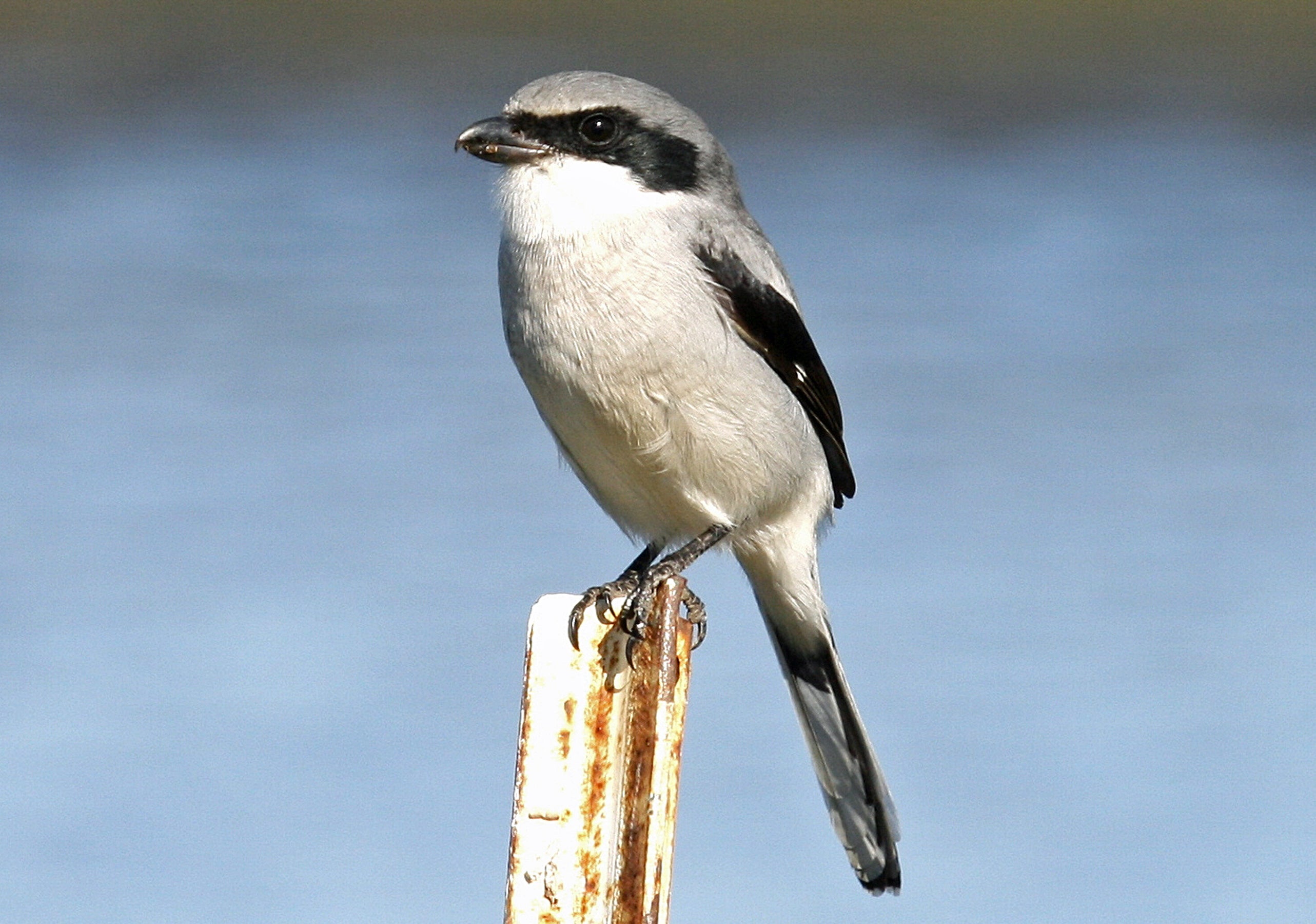By DAVID RAINER, Alabama Department of Conservation and Natural Resources
Appearing like a miniature version of a mockingbird, the loggerhead shrike looks like any other songbird until you find evidence of the shrike’s lethal side.
“Some people call them butcher birds or French mockingbirds,” said Eric Soehren, biologist and manager of the Alabama State Lands’ Wehle Land Conservation Center in southeast Alabama. “They may look similar to a mockingbird, but they are very different in many ways. The shrike is a predatory songbird. They prey on a variety of small animals and can even kill birds heavier than they are. Many times, you’ll see their larders, which is where they have skewered their prey on a thorn or barbed wire. That’s where the butcher bird name comes from. It’s a songbird, but it’s an efficient killing machine.”
Although common in the mid-20th century, the loggerhead shrike has become a species of greatest conservation need because of declining numbers throughout its range. Soehren said the bird has a very wide distribution across the continent, but numbers in latitudes north of a Missouri-Kentucky-Virginia line have plummeted. Where it used to be a common species, the birds are now only found in small and isolated populations.
Fortunately in the South, sizable numbers of these birds still remain, despite not being as numerous in places like Alabama and Mississippi.
In response to that decline, the Loggerhead Shrike Working Group (www.loggerheadshrike.org) was formed by researchers in Canada and the United States, made up of specialists who have studied the shrike as well as personnel from the non-game sections of state conservation agencies.
“One of their primary tasks is shrike conservation, monitoring trends, habitat management on conservation lands on a state-by-state basis,” Soehren said. “Places like Indiana, West Virginia and Virginia have contributed to this for quite some time. However, states in the Southeast have not been a part of this until more recently.”
Soehren said the group’s goal is to identify the problems affecting the shrike and why the species is declining. He said it’s likely a combination of impacts, like habitat alteration, pesticides and nest predation.
“The group is trying to use modern science on a comprehensive scale to identify these needs,” he said. “One of the biologists in Virginia reached out to us in Alabama and asked if we would participate in the group, first because we have a lot of shrikes, relatively speaking, and because they didn’t have a lot of representation in the Southeast.”
To further involve Alabama, the technical working group asked that the annual meeting be held in the state. That meeting was held last spring at the Birmingham Zoo. The Alabama Department of Conservation and Natural Resources was represented by Soehren, along with Carrie Threadgill and Mercedes Bartkovich from Alabama Wildlife and Freshwater Fisheries’ Non-Game Wildlife Section.
“One of the fundamental things of monitoring wildlife is to mark individuals, whether by banding, ear-tagging or radio collars in animals like deer,” Soehren said. “The idea is to see what happens to that individual animal during a course of time – their movements, their habitat use, longevity and survivorship. This has been going on all over the state.
“One of the things we’re looking at is the movements of the species. They are short-distance migrants. Birds that breed in the northern limits of their distribution range migrate south in the winter. A lot of the birds that come into north Alabama in the fall and winter are northern birds.”
Soehren said several state agencies have made a significant effort to band as many shrikes as possible. While the members of the working group are actively monitoring, the group also depends on the public to help with the effort.
“The idea is if you see a banded bird, report it,” he said.
A banding scheme with different color combinations was devised to provide re-sighting opportunities for researchers and casual observers. Birds banded in each state are assigned unique colored bands, making it easy to determine where the bird originated. A master list of color combinations for bands is compiled and managed by the group for identification.
“If a bird is sighted with color bands, there is a master list that can be used to say, ‘Oh, this bird was spotted in Alabama but banded in Virginia,'” said Soehren, who said the master list is reserved for the researchers.
Another aspect of the banding is being able to identify individual birds during the breeding cycle, like a paired male and female.
“A lot of the loss is likely happening at the nest,” Soehren said. “Pairs are nesting, raising young, but one of the critical aspects is that recruitment is falling below critical mass. It looks like a lot of the birds are not surviving through the first year. They may fledge, but they’re just not surviving.
“To better understand what’s going on, the birds are banded and monitored through the entire nesting process. It’s kind of a laborious effort, but if you have a good eye for finding nests, it will help us monitor these nests through the duration from nest building to fledging, and watching what the fledglings do afterwards.”
The working group is also collecting feathers and blood samples for genetics work to study the complexity of shrike populations across the continent.
“Understanding what population is where and how populations are mixing has conservation merit and bearing,” Soehren said. “If a population is found to be genetically unique, it deserves more immediate protection efforts than the populations that are more widespread and common.”








